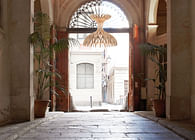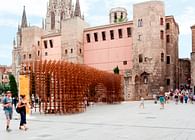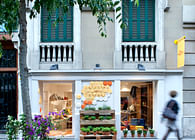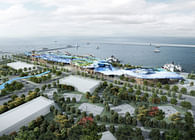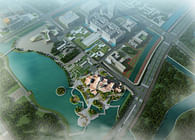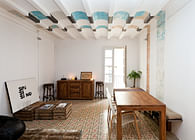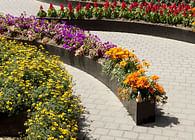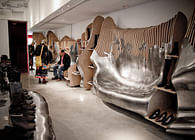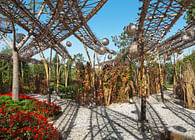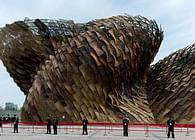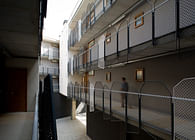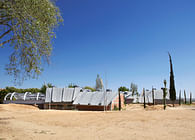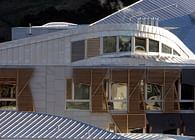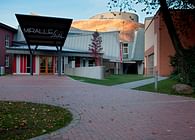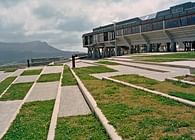
Barcelona, ES
HAFENCITY PUBLIC SPACE
The project develops a new public space within an existing harbour structure that is changed form a sea port into a city quarter, by regenerating and urbanizing the shores of the River Elbe in the town centre, and stands out by offering a great diversity of spaces to allow inhabitants and visitors to take advantage of the nearby waterway.
This is a further step for a sustainable restructuring of an industrial wasteland, preserving other territories from being newly colonised by the city growth.
The project is divided in 15 separate parcels in a total area of 150 000m2, with the main emphasis on integrating the existing historic heritage of the harbour into the new design development.
The new urban planning brings the public in a fluid movement from the new housing blocks down to the water, making for everyone’s enjoyment a new artificial landscape that is inhabited by natural elements: water and plants.
A system of ramps, stairways, and catwalks connect the three different levels:
Water level (±0,00) A big floating platform provides access to small boats, sport boats and ferryboats, as well as leisure areas. Special floating elements provide the presence of greenery and trees on the water level.
Low promenade level (+4,50) This level is mainly for pedestrians, host small cafes and permit a relax promenade overlooking the water. This level will be flooded only on specially bad days on an average of twice or three times a year.
Street level (+7,50) We provide pedestrian and playing places also at street level,
introducing here, as well as in the lower levels, the presence of water, of trees and green, of playing areas and promenades, indicated by pergolas.
Hamburg has always been a city which recognised and worked with the conditions of the surrounding. This is why the river Elbe was never controlled by locks, and the floods were accepted, by integrating the natural conditions from the beginning, in order to guarantee a sustainable planning of the area.
The flooding protection strategy is to give water space rather than contain it, in order to protect the rest of the city. Two thirds of the new public spaces are floodable. It is consciously accepted that they will be flooded, and they have been designed in consequence. They are not useless remaining spaces, but usable and liveable. The city is at a higher level, always protected from the water.
In terms of transportation the use of cars is reduced to street level. The docks zone and the terraces are only for walking and biking.
Traditional harbour materials and plants were used, which are sustainable and resistance to the climate, and where chosen to last for a long time period, such as brick, betonwerkstein, and native adaptive species as oak trees, willows, eschen, grass.
Hafencity can also be seen as a project that works on social, cultural, ecological and economics level. Its value on a European level is its complex integration of all issues of life.
Status: Built
Location: Hamburg, DE
Firm Role: Architect and Landscape Architect
Additional Credits:
HAFENCITY PUBLIC SPACE
Credits
Date: 2002 - 2015
Location: Hamburg, Germany
Client: Hafencity Hamburg GmbH
Type of project:First prize in competition, New Construction
Program: Public Space
Architect: Benedetta Tagliabue - Miralles Tagliabue EMBT
Project Director: Karl Unglaub
Project Team: Stefan Geenen, Elena Nedelcu.
Elena Rocchi, Jorge Carvajal, Eugenio Cirulli, Massimo Chizzola,
Santiago Crespi, Marco de Gregorio, Annunziata Dezio, Daniel
Domingo, Jörgen Dreher, Gianfranco Grondona, Joana Guerra, Simon Junge, Irene Kasjanenko, Maximilian Kneucker, Jan Kokol, Ana Catarina Miguel, Beatriz Minguez, Amanda Mori, Gordon Moss, Fernando Mota, Lucía Ortiz, Adelaide Pasetti, Jakob Pitroff, Judit Rigerszki, Elena Rocchi, Jorge Rollán, Thorsten Saul, Ida Sborgia, Alex Schmidt, Bastian Schubert, Kerstin Schwindt, Roberto Sforza, Alexandra Spiegel, Lidia Tomaro, Nuno Torres, Laura Valentini, Umberto Viotto, Henrike Wettner, Waldemar Wilwer, Sabine Zaharanski, Verena Vogler.
Local Architects: WES & Partner Landschaftsarchitekten
Construction: Boymann Gruppe, Glandorf
v. Oertzen, Elmshorn
Weilland + Kuck, Hamburg
Mâchler GmbH, Gaggenau
Klinker –und Naturstein-Kontor Emsland
Rheda-Wiedenbrück
GBL Gödde Beton, Wadersloh
Engineer Structure: Ing. B. Körting WTM
Site Area: 150.000m²

